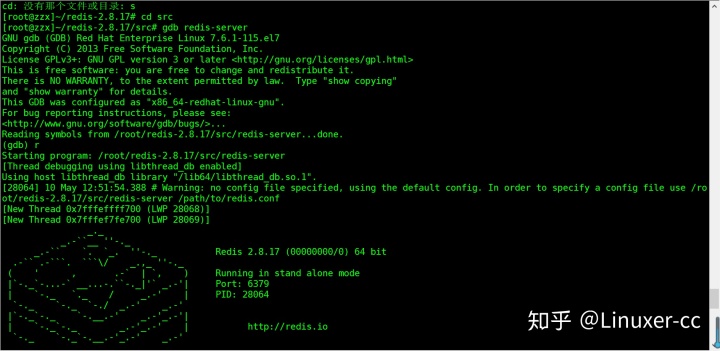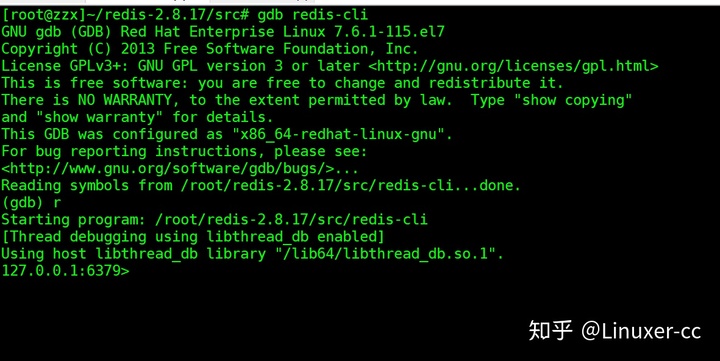Redis 网络通信模块源码分析
gdb不会用的先学下gdb
redis源码安装和编译
wget http://download.redis.io/releases/redis-2.8.17.tar.gz //可以下载新的
tar zxvf redis-2.8.17.tar.gz
cd redis-2.8.17
make -j 4编译成功后,会在 src 目录下生成多个可执行程序,其中 redis-server 和 redis-cli 是我们即将调试的程序。
进入 src 目录,使用 GDB 启动 redis-server 这个程序:

以上是 redis-server 启动成功后的画面。
我们再开一个 session,再次进入 Redis 源码所在的 src 目录,然后使用 GDB 启动 Redis 客户端 redis-cli:

上是 redis-cli 启动成功后的画面。
通信示例

侦听 socket
我们知道网络通信在应用层上的大致流程如下:
- 服务器端创建侦听 socket;
- 将侦听 socket 绑定到需要的 IP 地址和端口上(调用 Socket API bind 函数);
- 启动侦听(调用 socket API listen 函数);
- 无限等待客户端连接到来,调用 Socket API accept 函数接受客户端连接,并产生一个与该客户端对应的客户端 socket;
- 处理客户端 socket 上网络数据的收发,必要时关闭该 socket。
根据上面的流程,先来探究前三步的流程。由于 redis-server 默认对客户端的端口号是 6379,可以使用这个信息作为依据。
然后全局搜索一下 Redis 的代码,寻找调用了 bind() 函数的代码:

static int anetListen(char *err, int s, struct sockaddr *sa, socklen_t len, int backlog) {
if (bind(s,sa,len) == -1) {
anetSetError(err, "bind: %s", strerror(errno));
close(s);
return ANET_ERR;
}
if (listen(s, backlog) == -1) {
anetSetError(err, "listen: %s", strerror(errno));
close(s);
return ANET_ERR;
}
return ANET_OK;
}
gdb在这个函数上加个断点。

中断的时候查看一下函数调用栈

通过这个堆栈,结合堆栈 #2 的 6379 端口号可以确认这就是我们要找的逻辑,并且这个逻辑在主线程(因为从堆栈上看,最顶层堆栈是 main() 函数)中进行。
我们看下堆栈 #1 处的代码:
static int _anetTcpServer(char *err, int port, char *bindaddr, int af, int backlog)
{
int s = -1, rv;
char _port[6]; /* strlen("65535") */
struct addrinfo hints, *servinfo, *p;
snprintf(_port,6,"%d",port);
memset(&hints,0,sizeof(hints));
hints.ai_family = af;
hints.ai_socktype = SOCK_STREAM;
hints.ai_flags = AI_PASSIVE; /* No effect if bindaddr != NULL */
if ((rv = getaddrinfo(bindaddr,_port,&hints,&servinfo)) != 0) {
anetSetError(err, "%s", gai_strerror(rv));
return ANET_ERR;
}
for (p = servinfo; p != NULL; p = p->ai_next) {
if ((s = socket(p->ai_family,p->ai_socktype,p->ai_protocol)) == -1)
continue;
if (af == AF_INET6 && anetV6Only(err,s) == ANET_ERR) goto error;
if (anetSetReuseAddr(err,s) == ANET_ERR) goto error;
if (anetListen(err,s,p->ai_addr,p->ai_addrlen,backlog) == ANET_ERR) goto error;
goto end;
}
if (p == NULL) {
anetSetError(err, "unable to bind socket, errno: %d", errno);
goto error;
}
error:
if (s != -1) close(s);
s = ANET_ERR;
end:
freeaddrinfo(servinfo);
return s;
}
使用系统 API getaddrinfo 来解析得到当前主机的 IP 地址和端口信息。这里没有选择使用 gethostbyname 这个 API 是因为 gethostbyname 仅能用于解析 ipv4 相关的主机信息,而 getaddrinfo 既可以用于 ipv4 也可以用于 ipv6 ,这个函数的签名如下:
int getaddrinfo(const char *node, const char *service,
const struct addrinfo *hints,
struct addrinfo **res);
这个函数的具体用法可以在 Linux man 手册上查看。通常服务器端在调用 getaddrinfo 之前,将 hints 参数的 ai_flags 设置为 AI_PASSIVE,用于 bind;主机名 nodename 通常会设置为 NULL,返回通配地址 [::]。当然,客户端调用 getaddrinfo 时,hints 参数的 ai_flags 一般不设置 AI_PASSIVE,但是主机名 node 和服务名 service(更愿意称之为端口)则应该不为空。
解析完协议信息后,利用得到的协议信息创建侦听 socket,并开启该 socket 的 reuseAddr 选项。然后调用 anetListen 函数,在该函数中先 bind 后 listen。至此,redis-server 就可以在 6379 端口上接受客户端连接了。
接受客户端连接
同样的道理,要研究 redis-server 如何接受客户端连接,只要搜索 socket API accept 函数即可。
经定位,我们最终在 anet.c 文件中找到 anetGenericAccept 函数:
static int anetGenericAccept(char *err, int s, struct sockaddr *sa, socklen_t *len) {
int fd;
while(1) {
fd = accept(s,sa,len);
if (fd == -1) {
if (errno == EINTR)
continue;
else {
anetSetError(err, "accept: %s", strerror(errno));
return ANET_ERR;
}
}
break;
}
return fd;
}
我们用 b 命令在这个函数处加个断点,然后重新运行 redis-server。一直到程序全部运行起来,GDB 都没有触发该断点,这时新打开一个 redis-cli,以模拟新客户端连接到 redis-server 上的行为。断点触发了,此时查看一下调用堆栈。
Breakpoint 2, anetGenericAccept (err=0x745bb0 <server+560> "", s=s@entry=11, sa=sa@entry=0x7fffffffe2b0, len=len@entry=0x7fffffffe2ac) at anet.c:531
531 static int anetGenericAccept(char *err, int s, struct sockaddr *sa, socklen_t *len) {
(gdb) bt
#0 anetGenericAccept (err=0x745bb0 <server+560> "", s=s@entry=11, sa=sa@entry=0x7fffffffe2b0, len=len@entry=0x7fffffffe2ac) at anet.c:531
#1 0x0000000000427a1d in anetTcpAccept (err=<optimized out>, s=s@entry=11, ip=ip@entry=0x7fffffffe370 "317P237[", ip_len=ip_len@entry=46,
port=port@entry=0x7fffffffe36c) at anet.c:552
#2 0x0000000000437fb1 in acceptTcpHandler (el=<optimized out>, fd=11, privdata=<optimized out>, mask=<optimized out>) at networking.c:689
#3 0x00000000004267f0 in aeProcessEvents (eventLoop=eventLoop@entry=0x7ffff083a0a0, flags=flags@entry=11) at ae.c:440
#4 0x0000000000426adb in aeMain (eventLoop=0x7ffff083a0a0) at ae.c:498
#5 0x00000000004238ef in main (argc=<optimized out>, argv=0x7fffffffe588) at server.c:3894
分析这个调用堆栈,梳理一下这个调用流程。在 main 函数的 initServer 函数中创建侦听 socket、绑定地址然后开启侦听,接着调用 aeMain 函数启动一个循环不断地处理“事件”。
void aeMain(aeEventLoop *eventLoop) {
eventLoop->stop = 0;
while (!eventLoop->stop) {
if (eventLoop->beforesleep != NULL)
eventLoop->beforesleep(eventLoop);
aeProcessEvents(eventLoop, AE_ALL_EVENTS|AE_CALL_AFTER_SLEEP);
}
}
循环的退出条件是 eventLoop→stop 为 1。事件处理的代码如下:
int aeProcessEvents(aeEventLoop *eventLoop, int flags)
{
int processed = 0, numevents;
/* Nothing to do? return ASAP */
if (!(flags & AE_TIME_EVENTS) && !(flags & AE_FILE_EVENTS)) return 0;
/* Note that we want call select() even if there are no
* file events to process as long as we want to process time
* events, in order to sleep until the next time event is ready
* to fire. */
if (eventLoop->maxfd != -1 ||
((flags & AE_TIME_EVENTS) && !(flags & AE_DONT_WAIT))) {
int j;
aeTimeEvent *shortest = NULL;
struct timeval tv, *tvp;
if (flags & AE_TIME_EVENTS && !(flags & AE_DONT_WAIT))
shortest = aeSearchNearestTimer(eventLoop);
if (shortest) {
long now_sec, now_ms;
aeGetTime(&now_sec, &now_ms);
tvp = &tv;
/* How many milliseconds we need to wait for the next
* time event to fire? */
long long ms =
(shortest->when_sec - now_sec)*1000 +
shortest->when_ms - now_ms;
if (ms > 0) {
tvp->tv_sec = ms/1000;
tvp->tv_usec = (ms % 1000)*1000;
} else {
tvp->tv_sec = 0;
tvp->tv_usec = 0;
}
} else {
/* If we have to check for events but need to return
* ASAP because of AE_DONT_WAIT we need to set the timeout
* to zero */
if (flags & AE_DONT_WAIT) {
tv.tv_sec = tv.tv_usec = 0;
tvp = &tv;
} else {
/* Otherwise we can block */
tvp = NULL; /* wait forever */
}
}
/* Call the multiplexing API, will return only on timeout or when
* some event fires. */
numevents = aeApiPoll(eventLoop, tvp);
/* After sleep callback. */
if (eventLoop->aftersleep != NULL && flags & AE_CALL_AFTER_SLEEP)
eventLoop->aftersleep(eventLoop);
for (j = 0; j < numevents; j++) {
aeFileEvent *fe = &eventLoop->events[eventLoop->fired[j].fd];
int mask = eventLoop->fired[j].mask;
int fd = eventLoop->fired[j].fd;
int rfired = 0;
/* note the fe->mask & mask & ... code: maybe an already processed
* event removed an element that fired and we still didn't
* processed, so we check if the event is still valid. */
if (fe->mask & mask & AE_READABLE) {
rfired = 1;
fe->rfileProc(eventLoop,fd,fe->clientData,mask);
}
if (fe->mask & mask & AE_WRITABLE) {
if (!rfired || fe->wfileProc != fe->rfileProc)
fe->wfileProc(eventLoop,fd,fe->clientData,mask);
}
processed++;
}
}
/* Check time events */
if (flags & AE_TIME_EVENTS)
processed += processTimeEvents(eventLoop);
return processed; /* return the number of processed file/time events */
}
这段代码先通过 flag 参数检查是否有事件需要处理。如果有定时器事件( AE_TIME_EVENTS 标志 ),则寻找最近要到期的定时器。
/* Search the first timer to fire.
* This operation is useful to know how many time the select can be
* put in sleep without to delay any event.
* If there are no timers NULL is returned.
*
* Note that's O(N) since time events are unsorted.
* Possible optimizations (not needed by Redis so far, but...):
* 1) Insert the event in order, so that the nearest is just the head.
* Much better but still insertion or deletion of timers is O(N).
* 2) Use a skiplist to have this operation as O(1) and insertion as O(log(N)).
*/
static aeTimeEvent *aeSearchNearestTimer(aeEventLoop *eventLoop)
{
aeTimeEvent *te = eventLoop->timeEventHead;
aeTimeEvent *nearest = NULL;
while(te) {
if (!nearest || te->when_sec < nearest->when_sec ||
(te->when_sec == nearest->when_sec &&
te->when_ms < nearest->when_ms))
nearest = te;
te = te->next;
}
return nearest;
}
这段代码有详细的注释,也非常好理解。注释告诉我们,由于这里的定时器集合是无序的,所以需要遍历一下这个链表,算法复杂度是 O(n) 。同时,注释中也“暗示”了我们将来 Redis 在这块的优化方向,即把这个链表按到期时间从小到大排序,这样链表的头部就是我们要的最近时间点的定时器对象,算法复杂度是 O(1) 。或者使用 Redis 中的 skiplist ,算法复杂度是 O(log(N)) 。
接着获取当前系统时间( aeGetTime(&now_sec, &now_ms); )将最早要到期的定时器时间减去当前系统时间获得一个间隔。这个时间间隔作为 numevents = aeApiPoll(eventLoop, tvp); 调用的参数,aeApiPoll() 在 Linux 平台上使用 epoll 技术,Redis 在这个 IO 复用技术上、在不同的操作系统平台上使用不同的系统函数,在 Windows 系统上使用 select,在 Mac 系统上使用 kqueue。这里重点看下 Linux 平台下的实现:
static int aeApiPoll(aeEventLoop *eventLoop, struct timeval *tvp) {
aeApiState *state = eventLoop->apidata;
int retval, numevents = 0;
retval = epoll_wait(state->epfd,state->events,eventLoop->setsize,
tvp ? (tvp->tv_sec*1000 + tvp->tv_usec/1000) : -1);
if (retval > 0) {
int j;
numevents = retval;
for (j = 0; j < numevents; j++) {
int mask = 0;
struct epoll_event *e = state->events+j;
if (e->events & EPOLLIN) mask |= AE_READABLE;
if (e->events & EPOLLOUT) mask |= AE_WRITABLE;
if (e->events & EPOLLERR) mask |= AE_WRITABLE;
if (e->events & EPOLLHUP) mask |= AE_WRITABLE;
eventLoop->fired[j].fd = e->data.fd;
eventLoop->fired[j].mask = mask;
}
}
return numevents;
}
epoll_wait 这个函数的签名如下:
int epoll_wait(int epfd, struct epoll_event *events, int maxevents, int timeout);最后一个参数 timeout 的设置非常有讲究,如果传入进来的 tvp 是 NULL ,根据上文的分析,说明没有定时器事件,则将等待时间设置为 -1 ,这会让 epoll_wait 无限期地挂起来,直到有事件时才会被唤醒。挂起的好处就是不浪费 CPU 时间片。反之,将 timeout 设置成最近的定时器事件间隔,将 epoll_wait 的等待时间设置为最近的定时器事件来临的时间间隔,可以及时唤醒 epoll_wait ,这样程序流可以尽快处理这个到期的定时器事件(下文会介绍)。
对于 epoll_wait 这种系统调用,所有的 fd(对于网络通信,也叫 socket)信息包括侦听 fd 和普通客户端 fd 都记录在事件循环对象 aeEventLoop 的 apidata 字段中,当某个 fd 上有事件触发时,从 apidata 中找到该 fd,并把事件类型(mask 字段)一起记录到 aeEventLoop 的 fired 字段中去。我们先把这个流程介绍完,再介绍 epoll_wait 函数中使用的 epfd 是在何时何地创建的,侦听 fd、客户端 fd 是如何挂载到 epfd 上去的。
在得到了有事件的 fd 以后,接下来就要处理这些事件了。在主循环 aeProcessEvents 中从 aeEventLoop 对象的 fired 数组中取出上一步记录的 fd,然后根据事件类型(读事件和写事件)分别进行处理。
for (j = 0; j < numevents; j++) {
aeFileEvent *fe = &eventLoop->events[eventLoop->fired[j].fd];
int mask = eventLoop->fired[j].mask;
int fd = eventLoop->fired[j].fd;
int rfired = 0;
/* note the fe->mask & mask & ... code: maybe an already processed
* event removed an element that fired and we still didn't
* processed, so we check if the event is still valid. */
if (fe->mask & mask & AE_READABLE) {
rfired = 1;
fe->rfileProc(eventLoop,fd,fe->clientData,mask);
}
if (fe->mask & mask & AE_WRITABLE) {
if (!rfired || fe->wfileProc != fe->rfileProc)
fe->wfileProc(eventLoop,fd,fe->clientData,mask);
}
processed++;
}
读事件字段 rfileProc 和写事件字段 wfileProc 都是函数指针,在程序早期设置好,这里直接调用就可以了。
typedef void aeFileProc(struct aeEventLoop *eventLoop, int fd, void *clientData, int mask);
/* File event structure */
typedef struct aeFileEvent
int mask; /* one of AE_(READABLE|WRITABLE) */
aeFileProc *rfileProc;
aeFileProc *wfileProc;
void *clientData;
} aeFileEvent;
15.3 epollfd 的创建
我们通过搜索关键字 epoll_create 在 ae_epoll.c 文件中找到 EPFD 的创建函数 aeApiCreate 。
static int aeApiCreate(aeEventLoop *eventLoop) {
aeApiState *state = zmalloc(sizeof(aeApiState));
if (!state) return -1;
state->events = zmalloc(sizeof(struct epoll_event)*eventLoop->setsize);
if (!state->events) {
zfree(state);
return -1;
}
state->epfd = epoll_create(1024); /* 1024 is just a hint for the kernel */
if (state->epfd == -1) {
zfree(state->events);
zfree(state);
return -1;
}
eventLoop->apidata = state;
return 0;
}
使用 GDB 的 b 命令在这个函数上加个断点,然后使用 run 命令重新运行一下 redis-server,触发断点,使用 bt 命令查看此时的调用堆栈。发现 EPFD 也是在上文介绍的 initServer 函数中创建的。
(gdb) bt
#0 aeCreateEventLoop (setsize=10128) at ae.c:79
#1 0x000000000042f542 in initServer () at server.c:1841
#2 0x0000000000423803 in main (argc=<optimized out>, argv=0x7fffffffe588) at server.c:3857
在 aeCreateEventLoop 中不仅创建了 EPFD,也创建了整个事件循环需要的 aeEventLoop 对象,并把这个对象记录在 Redis 的一个全局变量的 el 字段中。这个全局变量叫 server,这是一个结构体类型。其定义如下:
//位于 server.c 文件中
struct redisServer server; /* Server global state */
//位于 server.h 文件中
struct redisServer {
/* General */
//省略部分字段...
aeEventLoop *el;
unsigned int lruclock; /* Clock for LRU eviction */
//太长了,省略部分字段...
}





















 547
547











 被折叠的 条评论
为什么被折叠?
被折叠的 条评论
为什么被折叠?








